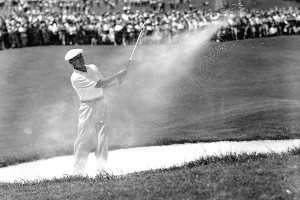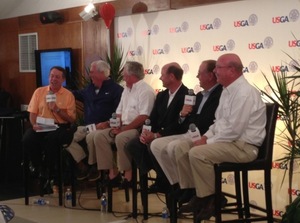The U.S. Open's return to Merion marks Tweeter Supreme and mutiple-award winning writer Dan Jenkins' 60th U.S. Open, a milestone he marked in the June Golf Digest with his favorite players, courses, holes and even constructive criticism through the years. And for the sixth straight year, he answers my softballs in anticipation of America's national championship.
 Previous U.S. Open Q&A's can be read in order, here, here, here, here and here.
Previous U.S. Open Q&A's can be read in order, here, here, here, here and here.
GS: Big return to Merion, judging by your comments in the June Golf Digest, this is a favorite US Open venue of yours? How so?
DJ: I guess I like Merion a lot because of these things. History, "Merion lightning" (the greens). flag baskets, quarry holes. It's one of my three favorite courses to play and look at, the other two being Pine Valley and Cypress Point.
GS: Your man Hogan sealed his comeback at Merion. Was it his greatest performance?
DJ: Merion wasn't Hogan's best golf, just his timeliest and most historic. His best golf came in the last round at Oakland Hills in '51, and all week long at Oakmont in '53. Study his career and you find his game at its best when his obstacles were the toughest.
GS: Did you ever talk to Hogan about Merion, the 1-iron or the Hy Peskin shot?
DJ: I do wish I'd been at Merion in '50---I didn't start covering the majors until '51---but I talked to him about it many times over the years. It wasn't a 1-iron, by the way. It was a 2-iron. That's what he always told me. Once in later years he even said it was a 3-iron. To get more of this you'll have to read my "journalism memoir" that's coming out from Doubleday sometime around the first of the year. The Mystery of the Stolen One-Iron at Merion is part of two long chapters on Ben.
GS: Does the book contain any words of wisdom about the state of journalism and the media industry in this time of "transition"?
DJ: Of course it does. But nothing to put in a scrapbook.
GS: Sergio, your sometimes Twitter alter ego, will be setting foot on American soil for the first time since his fried chicken remark. Will you be brokering peace settlement talks between he and Tiger and Tiger and Sergio and your ownself?
DJ: Knowing me, Geoff, surely you know I don't much care about Tiger or his feuds, even those with Sergio, except for the comedy involved. I love it that people ask me about Tiger all the time. I really don't know what I'm expected to say. I do say he's the greatest putter I've ever seen, and the greatest reader of greens. But ask me to place him somewhere in golf history, and I still have him behind a lot of players who did more for the game at the time of their peak years, those gentlemen being, not in any particular order, Hogan, Snead, Byron, Jones, Hagen, Arnold, Jack, Gary, and even Demaret, Trevino, and Seve. But of course I'm a geezer.
GS: Is the journalism book it in that mysterious phase where the publisher accepts it and then spends a year sitting on it? What's it called?
DJ: I was dragged kicking and screaming to the title of my book that the publisher has insisted on: HIS OWNSELF----A Semi-Memoir. I was thinking A Farewell to Arms had a ring to it.
See you at Merion.
 But hey, there's always the mute button.
But hey, there's always the mute button.















